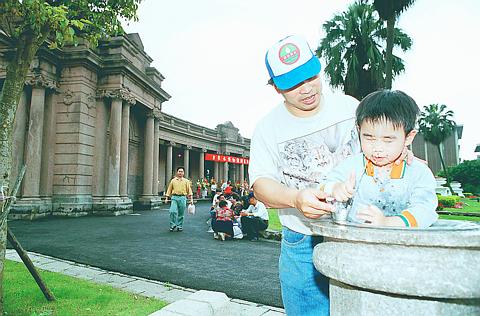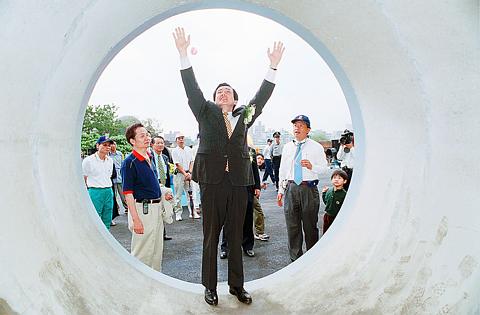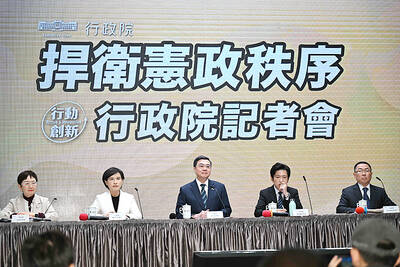Taiwan's first museum devoted to drinking water reopened yesterday to coincide with Labor Day celebration activities.
Holding a cup of tap water in his hand at yesterday's opening ceremony, Taipei City Mayor Ma Ying-jeou (馬英九) recounted a childhood anecdote.
"When I was little, I used to drink tap water without my parents' knowledge, because it was not safe to drink," he said. "Now I drink it everyday both at work and at home."

PHOTO: GEORGE TSORNG, TAIPEI TIMES
According to Ma, piped water was available in Taipei from 1885. But it was not until Taiwan's retrocession in 1945 that tap water became completely accessible to the general public -- and has now "come of age"
"Drinkable water is an indicator of modernization," Ma said.
To prove the safety of the city's water, Ma gulped down the water in the cup, then asked for more.

PHOTO: GEORGE TSORNG, TAIPEI TIMES
"Even though it's just a small cup, it takes a lot of people's efforts to make it possible," Ma said.
The reopening of the museum has historical significance.
The Baroque-style building which houses the museum was originally built in 1908, and declared a third-class historic site in 1993.
It houses nine water pumps which were used to draw off water from Hsintien River. The water was then purified at the water treatment facility before being sent on to a reservoir at Kuanyin Mountain (觀音山).
However, because of the deterioration in the quality of the water supply, the pumping facility was relocated northward to the upper stream at Chingtanyen (青潭堰) in 1977.
The water treatment facility then became the third of its kind for the city, treating 520,000 tons of water everyday.
The museum was first open in September 1993, but was shut down in 1998 for renovation.
The NT$80 million, two-year project has instilled new life in the main building and the surrounding 7,800-ping (25,740 square meter) area, which includes the water treatment facility, an outdoor equipment display area, a hillside sidewalk area, and a playground.
Tsay Huel-sheng (蔡輝昇), director general of the Taipei Water Department (台北自來水事業處), said the establishment of the museum has its own purpose.
"We would like the public to know that water is a valuable and non-replaceable natural resource," he said.
"Ninety-seven percent of the earth's water is seawater, while three percent is fresh water, but of that three percent, three-fourths of it is located in the area of the Arctic and Antarctic Poles, so that leaves us a fairly limited amount of fresh water available," Tsay said.
Tsay also cited the impressive performance of the department, citing gross revenue from January through March this year to have been registered at NT$560 million, about NT$200 million more than targeted. Tsay said he expects the number to reach NT$720 million in two months.
The Drinking Water Museum is located at No. 1, Szuyuan Street in the Kungkuan area. It is open to the public daily from 9am to 5pm. Tickets are NT$60 for adults, and NT$30 for the disabled, senior citizens, students, and soldiers. There is an additional NT$50 charge for each car and NT$150 per bus.
Those interested in visiting the facility can take advantage of the mass transit system, and get off at the Kungkuan stop. The museum is five minutes away on foot on the way to the Yungfu Bridge.

The US government has signed defense cooperation agreements with Japan and the Philippines to boost the deterrence capabilities of countries in the first island chain, a report by the National Security Bureau (NSB) showed. The main countries on the first island chain include the two nations and Taiwan. The bureau is to present the report at a meeting of the legislature’s Foreign Affairs and National Defense Committee tomorrow. The US military has deployed Typhon missile systems to Japan’s Yamaguchi Prefecture and Zambales province in the Philippines during their joint military exercises. It has also installed NMESIS anti-ship systems in Japan’s Okinawa

‘WIN-WIN’: The Philippines, and central and eastern European countries are important potential drone cooperation partners, Minister of Foreign Affairs Lin Chia-lung said Minister of Foreign Affairs Lin Chia-lung (林佳龍) in an interview published yesterday confirmed that there are joint ventures between Taiwan and Poland in the drone industry. Lin made the remark in an exclusive interview with the Chinese-language Liberty Times (the Taipei Times’ sister paper). The government-backed Taiwan Excellence Drone International Business Opportunities Alliance and the Polish Chamber of Unmanned Systems on Wednesday last week signed a memorandum of understanding in Poland to develop a “non-China” supply chain for drones and work together on key technologies. Asked if Taiwan prioritized Poland among central and eastern European countries in drone collaboration, Lin

NO CONFIDENCE MOTION? The premier said that being toppled by the legislature for defending the Constitution would be a democratic badge of honor for him Premier Cho Jung-tai (卓榮泰) yesterday announced that the Cabinet would not countersign the amendments to the local revenue-sharing law passed by the Legislative Yuan last month. Cho said the decision not to countersign the amendments to the Act Governing the Allocation of Government Revenues and Expenditures (財政收支劃分法) was made in accordance with the Constitution. “The decision aims to safeguard our Constitution,” he said. The Constitution stipulates the president shall, in accordance with law, promulgate laws and issue mandates with the countersignature of the head of the Executive Yuan, or with the countersignatures of both the head of the Executive Yuan and ministers or

CABINET APPROVAL: People seeking assisted reproduction must be assessed to determine whether they would be adequate parents, the planned changes say Proposed amendments to the Assisted Reproduction Act (人工生殖法) advanced yesterday by the Executive Yuan would grant married lesbian couples and single women access to legal assisted reproductive services. The proposed revisions are “based on the fundamental principle of respecting women’s reproductive autonomy,” Cabinet spokesperson Michelle Lee (李慧芝) quoted Vice Premier Cheng Li-chiun (鄭麗君), who presided over a Cabinet meeting earlier yesterday, as saying at the briefing. The draft amendment would be submitted to the legislature for review. The Ministry of Health and Welfare, which proposed the amendments, said that experts on children’s rights, gender equality, law and medicine attended cross-disciplinary meetings, adding that